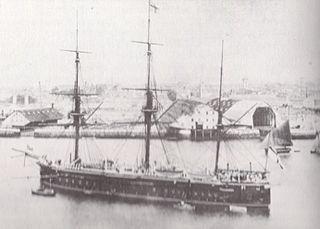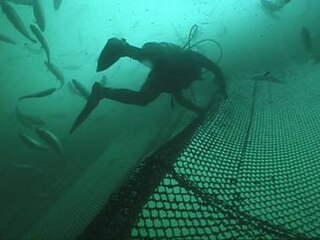
Bronze is an alloy consisting primarily of copper, commonly with about 12–12.5% tin and often with the addition of other metals and sometimes non-metals, such as phosphorus, or metalloids, such as arsenic or silicon. These additions produce a range of alloys that may be harder than copper alone, or have other useful properties, such as strength, ductility, or machinability.

A clipper was a type of mid-19th-century merchant sailing vessel, designed for speed. The term was also retrospectively applied to the Baltimore clipper, which originated in the late 18th century.

Cutty Sark is a British clipper ship. Built on the River Leven, Dumbarton, Scotland in 1869 for the Jock Willis Shipping Line, she was one of the last tea clippers to be built and one of the fastest, at the end of a long period of design development for this type of vessel, which ended as steamships took over their routes. She was named after the short shirt of the fictional witch in Robert Burns' poem Tam o' Shanter, first published in 1791.

Cupronickel or copper–nickel (CuNi) is an alloy of copper with nickel, usually along with small quantities of other elements added for strength, such as iron and manganese. The copper content typically varies from 60 to 90 percent.

Anti-fouling paint is a specialized category of coatings applied as the outer (outboard) layer to the hull of a ship or boat, to slow the growth of and facilitate detachment of subaquatic organisms that attach to the hull and can affect a vessel's performance and durability. It falls into a category of commercially available underwater hull paints, also known as bottom paints.

A treenail, also trenail, trennel, or trunnel, is a wooden peg, pin, or dowel used to fasten pieces of wood together, especially in timber frames, covered bridges, wooden shipbuilding and boat building. It is driven into a hole bored through two pieces of structural wood.

Hercules Linton was a Scottish surveyor, designer, shipbuilder, antiquarian and local councillor, best known as the designer of the Cutty Sark and partner in the yard of Scott and Linton, which built her.

Mineral-insulated copper-clad cable is a variety of electrical cable made from copper conductors inside a copper sheath, insulated by inorganic magnesium oxide powder. The name is often abbreviated to MICC or MI cable, and colloquially known as pyro. A similar product sheathed with metals other than copper is called mineral-insulated metal-sheathed (MIMS) cable.

A metal roof is a roofing system featuring metal pieces or tiles exhibiting corrosion resistance, impermeability to water, and long life. It is a component of the building envelope. The metal pieces may be a covering on a structural, non-waterproof roof, or they could be self-supporting sheets.

The Swiftsure class battleships of the late Victorian era were broadside ironclads designed and built specifically for service as Flagships on the Pacific station.

Copper sheathing is a method for protecting the hull of a wooden vessel from attack by shipworm, barnacles and other marine growth through the use of copper plates affixed to the surface of the hull, below the waterline. It was pioneered and developed by the Royal Navy during the 18th century. In antiquity, ancient Chinese used copper plates while ancient Greeks used lead plates to protect the underwater hull.

George Frederick Muntz was an industrialist from Birmingham, England and a Liberal Party Member of Parliament (MP) for the Birmingham constituency from 1840 until his death.
The technique of composite ship construction emerged in the mid-19th century as the final stage in the evolution of fast commercial sailing ships.
The Diamond was a three-masted square rigger, built in New York City in 1823. She was one of the first ships to operate a regular service for passenger and cargo between Britain and the United States. She sank en route to Liverpool from New York on 2 January 1825 in Cardigan Bay. The alleged wreck site was identified in 2000 and was designated under the Protection of Wrecks Act 1973 on 1 April 2002, the first such designation by the National Assembly for Wales. However, the identification has since been called into question.
Composite construction is a generic term to describe any building construction involving multiple dissimilar materials. Composite construction is often used in building aircraft, watercraft, and building construction. There are several reasons to use composite materials including increased strength, aesthetics, and environmental sustainability.

Metals used for architectural purposes include lead, for water pipes, roofing, and windows; tin, formed into tinplate; zinc, copper and aluminium, in a range of applications including roofing and decoration; and iron, which has structural and other uses in the form of cast iron or wrought iron, or made into steel. Metal alloys used in building include bronze ; brass ; monel metal and nickel silver, mainly consisting of nickel and copper; and stainless steel, with important components of nickel and chromium.

Copper alloys are important netting materials in aquaculture. Various other materials including nylon, polyester, polypropylene, polyethylene, plastic-coated welded wire, rubber, patented twine products, and galvanized steel are also used for netting in aquaculture fish enclosures around the world. All of these materials are selected for a variety of reasons, including design feasibility, material strength, cost, and corrosion resistance.
SS United States was a merchant steamship launched in 1864 and lost off Cape Romain, South Carolina, in 1881. She was the most expensive steamer built by the American shipbuilding firm of S. Gildersleeve & Son, which built 120 vessels. The vessel was named for her country and sported the United States' national symbol, an American eagle, as her figurehead.

Galvanic corrosion is an electrochemical process in which one metal corrodes preferentially when it is in electrical contact with another, in the presence of an electrolyte. A similar galvanic reaction is exploited in primary cells to generate a useful electrical voltage to power portable devices. This phenomenon is named after Italian physician Luigi Galvani (1737–1798).
















